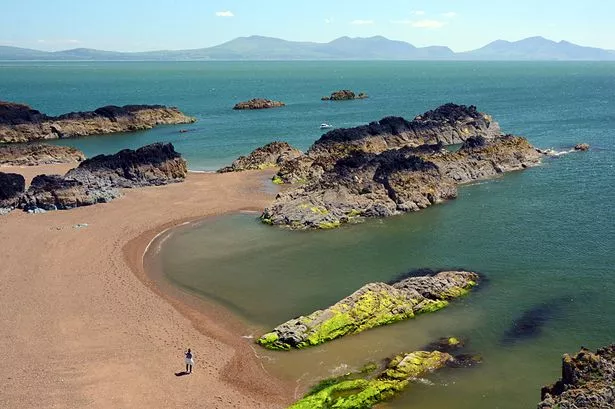Alan Carr is back with a new series of Changing Ends – however, he may be following in the footsteps of his Celebrity Traitors co-star Claudia Winkleman as Strictly’s new host
The job offers haven’t stopped rolling in for Alan Carr since his momentous Celebrity Traitors win, with the comedian even tipped to take over hosting duties on BBC One’s Strictly Come Dancing. While he’s back with a new series of his hit comedy Changing Ends, the 49-year-old admits he’s unsure whether he could handle the challenge of stepping into Claudia Winkleman and Tess Daly’s sparkly shoes.
“My name is in the hat,” he says. “What an honour. It’s a bit like when my name got bandied about for Britain’s Got Talent and The Great British Bake Off – I’m always on the periphery.
“I don’t know how serious it is. No one has approached me. People are so passionate about it and you saw me sweating in the castle when I was a Traitor, imagine me doing live telly with how many million people watching!”
READ MORE: BBC Celebrity Traitors star admits ‘one thing dawned on me early on’READ MORE: Celebrity Traitors finalist says ‘this is what Claudia Winkleman was really like’
Although, after a star turn on The Celebrity Traitors, he knows how to convincingly lie – and that could come in handy on Strictly. “If someone’s cha-cha-cha is a bit s**t, I’ve got the poker face!” he jokes.
“So many things have come from The Celebrity Traitors – so many job offers coming in – I’d be flattered but I don’t know if I could do it [Strictly] justice. I just don’t want to ruin it for people.”
Alan is back on more familiar ground with Changing Ends – the semi-autobiographical sitcom about his childhood in 1980s Northampton. Series three follows teenage Alan (played by Bafta nominee Oliver Savell) as he navigates obstacles such as stressful swimming lessons, and, more importantly, his first big crush – young Alan is smitten with Jake, the Saturday boy at the charity shop.
“I really got into charity shopping,” Alan smiles. “I used to go in there every Saturday and flick through the posters to catch his eye. I must have stunk like an old woman because I would get flares, I wore my dad’s sheepskin and we didn’t have dry cleaning like we do these days.
“I just wanted to be in love really. It still hasn’t happened!” With Alan now single after divorcing ex-husband Paul Drayton back in 2022, is he hoping his teenage crush will reach the real-life inspiration behind Jake?
“The boy knew then because I was just as unsubtle as I am now,” he laughs. “When I went back to Northampton, I saw him queuing up at a cash point. My knees went to jelly and I thought, ‘Oh my God, there he is.’ But I didn’t want to say hi.
“There’s still something there, but I don’t want a Surprise Surprise moment. He had his chance and he missed it! He could be dating a national treasure now.”
Fans will already know that Alan’s father Graham was famous himself – having been a professional footballer in the 1960s who went on to manage Northampton Town among other clubs. However, the new series also sees Alan’s mother Christine embracing life as a local WAG.
“We would drop my brother [Gary] off at Beavers and me and mum would sit in the Tesco café for an hour with a cup of tea and a Chelsea bun,” he says. “I remember this woman coming over in the canteen to ask for an autograph – I mean, it was funny.
“It sounds weird but in Northampton, my dad was famous – people would stop him. My mum didn’t get the same standard as my dad, but it was funny. She was stopped a few times and people whispered, ‘That’s Graham Carr’s wife.’ Now she gets, ‘That’s Alan Carr’s mum – that’s the Traitor’s mum!’”
Christine isn’t always pleased with how Alan portrays his childhood, with Nancy Sullivan and Shaun Dooley playing his long-suffering parents. “My mum goes, ‘Oh Alan, it wasn’t that obvious you were gay when you were a child.’ My mum, bless her – she’s still that she-wolf who goes up the school. ‘Don’t you pick on my Alan, he does fancy girls!’ I don’t think she realises how camp I am, she just loves me.”
Both his parents visited the show’s “surreal” set in Enfield, north London, which completely recreates his childhood home. “My poor dad walked up the stairs and nearly fell to his death because he thought the bedroom was upstairs,” he says. “How weird is that? It’s identical to the house. To have it decompartmentalised in a warehouse is so strange.”
As for whether we can expect more episodes of Changing Ends in the future, Alan says that it’s up to the fans. “I like the stage it’s at – that weird puberty stage,” he says. “If people are watching and they want it to come back, I’ll think about writing some more.
“But when it gets to the call centre years at 18 and when I started packing shampoo and dog food, I think I’m going to run out of stories because that was a really bleak time. It could be like The Office and be called The Warehouse!”
Although, after managing to make it all the way to the very end of The Celebrity Traitors without being found out as a Traitor, Alan is concerned that viewers won’t trust him any more. “I want it to be really authentic, but I worry now after doing The Celebrity Traitors people aren’t going to believe a word of Changing Ends!” he laughs.
Changing Ends airs Sunday at 10:05pm on ITV1 and ITVX.
Join The Mirror’s WhatsApp Community or follow us on Google News , Flipboard , Apple News, TikTok , Snapchat , Instagram , Twitter , Facebook , YouTube and Threads – or visit The Mirror homepage.





